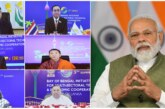[This is the revised version of the discussion author had as a Panelist at the #IUKANConference2014 held in New Delhi on 13 February 2014.]
Current models of #urbanplanning and #watermanagement are exceedingly proving insufficient from the perspective of cost effectiveness, technical performance, social equity, and environmental sustainability. Hence a paradigm shift is required at the system-wide level in the form of #IntegratedUrbanWaterManagement (#IUWM), which addresses tradeoffs among water users: #agriculture, #industry, #household, and #ecosystems. IUWM calls for new objectives that recognize the mutual benefits of #waterresources, #energy and #landusemanagement. In order to address the challenges of cities, the following principles of IUWM should be applied: Involving all stakeholders, Considering the entire #watercycle as one system, Assessing a portfolio of water sources, Maximizing the benefits from wastewater; Designing adaptive systems; #UrbanWaterCatchmentManagement, #Integratedfloodmanagement; and low cost, high impact solutions.
#RighttoWaterandIUWM
The #NationalWaterFramework Bill 2013 envisages that every individual has a right to a minimum quantity of #potablewater for essential health and hygiene and within easy reach of the household. The draft further adds that the minimum quantity of potable water shall not be less than 25 litres per capita per day, and that the quantity must be fixed by the “appropriate government”.
#CivilSocietyOrganizations (CSOs), including #IndiaWaterFoundation, are increasingly concerned by some of the provisions in the Framework Bill and the fact that some states would appear to be simply copying this bill without taking into account the uniqueness and the distinct #agroecologicalzones of each state. Besides, the Bill has already drawn criticism from several states like #Kerala and #Haryana, which have claimed that it amounts to infringing upon their rights as water is a state subject.
In our opinion, such a right should not be limited to just #drinkingwater, but should include the #righttowater for #livelihoods and for social and cultural needs also. While this may still be some way off, one can at least hope for a quick recognition of the right to drinking water and #sanitation as a #fundamentalright of its own standing.
While noting that the government remains the trustee of #waterresources, the draft bill gives it the flexibility of roping in private sector for “some of the functions of the state”. In this context, it stipulates that “allocation and pricing” should be based “on #economicprinciples to ensure its #developmentcosts”, and “so that water is not wasted in unnecessary uses and… utilized more gainfully and water infrastructure projects are made financially viable.”
However, the visible threats from #corporatization/#privatization of drinking water would be many such as #waterpricehikes, water-mining and bulk exports, monopolistic water market sub standard #waterquality, threat to community ownership of #waterresource, corruption and lack of transparency. As a case study, if we look into the #Shivanathriverproject (#Chhattisgarh), the first case of river privatization in India with total expected cost of Rs256 crore had terrible outcomes such as supplying water at the rate of Rs.12.60/liter to industries and to railways, people denied access for fishing and bathing, media reports indicated case of this privatized river slowly drying-up, a monopoly on the water supply in the radius of 18km, government announced the scheme was constitutionally illegal and later they revoked the contract.
Besides, the Framework Bill does not take into consideration the plight of dalits and the problems they face in accessing water. Broadly speaking, the differences between dalits and non- dalits household in respect of drinking water is as follow: 27% dalit households have water sources within premises as compared to 45.2% for the general populations.19.5% of dalit households have access to #drinkingwatersources away from their premises whereas it stands at 14.45 for the general population. 32.2% of dalit households have access to drinking water from tap as compared to 40.1% for the general population.
The private sector, especially the #SMEs, should be encouraged to invest in infrastructure in water segment without jeopardizing the interests of the weaker sections and the dalits. The local government should ensure proper control, transparent management and accountability of the private sector. There should be adequate legal provision for the involvement of the #CSOs from state to local levels to ensure the proper #implementationofRighttoWater.
#IndigenousApproach
It has generally observed that the Central and State Planning bodies look upon city level water and sanitation issues in a macro perspective without taking into consideration the #localgeographical, #socioeconomic and #culturalconsiderations and such a perspective devoid of local ground realities has often proved ineffective in tackling #water and #sanitation related issues at city level satisfactorily.
A comparative overview of the 2002 #NationalWaterPolicy and 2012 National Water Policy as well as #StateWaterPolicies of some states for the same periods makes it discernible that most of the states have copied the #NationalWaterPolicy with very minor changes. However, keeping in view the vast diversities prevalent in India in terms of geography, socio-economic conditions and cultural as well as religious customs a singular water policy cannot meet the diverse requirements owing to regional variations. Besides, cultural and religious aspects linked with water are also ignored.
A different set of policy measures is called for the cities located in the hilly areas, cities located in the coastal areas, cities located in arid and semi-arid areas etc. we strongly feel that even in a state, each city should have its water policy based on its requirements to cater to the needs of the local population. The district-level policies should form the basis of #StateLevelWaterPolicy by incorporating the common features of the cities. And the State-Level Policies should form the basis of National Water Policy with other inputs from international climate change perspectives and finance requirements for infrastructure for water sector.
The #Citylevelwaterplanmodel should emphasize on #waterconservation, involvement of all #stakeholders, #judicioususeofwater, #rainwaterharvesting, #theeffectiveuseoftechnology, frequent #capacitybuilding of the officials of the water department and the people; and ensuring cost-effectiveness.
The successful development and implementation of an #IntegratedUrbanWaterManagement (IUWM) plan is a crucial step for the realization of this vision. The primary purpose of the IUWM plan should be to develop the policies, programs and capital improvement plans necessary to fully achieve the #waterresourcemanagementgoals at the City level.
The City-level IUWM plan should be given the statutory form specifying City’s strategic priorities for at least a future five-year period, identify the goals, strategies, success indicators, funding sources, deliverables and milestones to accomplish the strategic priorities. The plan development process must include at least one publicly noticed meeting to allow #publicparticipation in its development. The annual work plan report must detail the #implementationofthestrategicplan for the previous fiscal year, addressing success #indicators, #deliverables and milestones.
Given this opportunity to streamline reporting to the State and more efficiently allocate staff time, the State should #galvanize all the cities on similar model and deploy an annual Strategic Plan, Annual Work Plan Report and these reports should be sent the #UnionWaterResourceMinistry by each State to enable the latter to formulate National Water Policy accordingly.
City-Level Planning
The City-level Integrated Urban Water Management (#IUWM) plan should contain sufficient measures to address the technological and logistic requirements of the #UrbanLocalBodies (#ULBs) as well as public #water and #sewerage operators along with their constant #capacitybuilding. The IUWM should ensure active role of the ULBs in managing water and related #naturalresources to ensure their continued availability while maximizing the benefits to the local population.
The City-level IUWM plan should provide a roadmap for the ULBs enabling them to meet the water resources challenges by identifying what needs to be accomplished, how the job will be done, and how success will be measured. In addition to identifying the City’s growing needs in #water and #sanitationsectors, the ULBs should identify specific priorities in their respective areas of operation and these inputs from the ULBs should be utilized by the City’s water department to prioritize project funding requests and to provide guidance to funding agencies of the State.
The following measures can assist the existing ecosystem at City-level to support resources and capacity building to newer and smaller ULBs:
- ULBs and other #stakeholders must move the #sanitation crisis to the top of the agenda.
- The City-level #waterdepartment and the #ULBs must ensure that policies and institutions for #watersupply and #sanitationservice delivery, as well as for water resources management and development, respond equally to the different roles, needs, and priorities of women and men.
- #StateGovernment must pursue investment and reforms.
- Efforts to reach the water and sanitation target must focus on sustainable service delivery, rather than construction of facilities alone.
- ULBs must #empowerlocalcommunities with the authority, resources, and professional capacity required to manage #watersupplyandsanitation service delivery.
- ULBs must also ensure that the needs of poor households are met.
- The City-level authorities must elaborate coherent #waterresourcesdevelopment and #managementplans that aim at #povertyreduction, #genderequity and #ecologicalbalance.
- Government, civil society and private sector partners must support a wide range of water and sanitation technologies and service levels that are technically, socially, #environmentally and financially appropriate.
- Institutional, financial, and technological innovation must be promoted in strategic areas at the state and City level.
#CivilSocietyRole
The #UrbanLocalBodies (#ULBs) in active cooperation with civil society can play crucial role in working out practical and scalable solution recycling of waste water that can be driven bottom-up from community side to the State level.
#IndiaWaterFoundation has some experience in recycling of #industrialwastewater. In November 2011, the #IWF organized an #InternationalConferenceonWaterUseEfficiencyinIndustrialSectoratJaipur (#Rajasthan) in collaboration with #RIICO, Govt. of Rajasthan. The outcome of this Conference has proved a game-changer in #watersector in Rajasthan because in the immediate aftermath of the conference, the government of Rajasthan enacted the #StateWaterLaw for the first time and concurrently the #DepartmentofIndustries of the state government announced allocation of additional plots to industrial units in the state to #installwatertreatmentplants for #recyclingofindustrialwastewater for #reuse. The IWF has been persuading other State Governments as well as industrial sector to emulate the example of Rajasthan.
#RoleoftheSMEs
The #SMEs have vast potential in facilitating management of #urbanwatersupply and #promotewater related #livelihood for the weaker sections of the society. As per existing practices the municipal #wastewater is treated at a specific location and the treated water is recycled. However, this process is very expensive in terms of installation of heavy machinery for water treatment and laying down of heavy pipelines for supply of #recycledwater to different destinations. Instead specific sites can be identified depending on the flow of #wastewater and #smallwatertreatmentplants can be installed on these sites and water thus treated can be recycled to meet local requirements. The services and expertise of the #SMEs can be roped in implementing such schemes of installing small waste water treatment plants.
The need for well-trained entrepreneurs is the catalyst for a #stableeconomy. Entrepreneurs often are persons whose performance in the public and private sector of an #economybalances the gaps between government and non-governmental activities. Through their engagement as leadership agents in society, Self reliant businesses are enhanced; skills acquisition is promoted and small and medium scale entrepreneurs given access to training and financial capital for their businesses.
The #SMEs in a city can form a nodal agency with the cooperation of #IWF to develop a system which uses an #integratedurbanwatermanagementapproach. This integrated approach should include several actions such as: (i) #interventionsovertheentireurbanwatercycle; (ii) #optimisationofwaterusebyreusingwastewater and #preventingpollutionoffreshwatersource; (iii) #prioritisationofsmallscalenaturalandtechnicalsystems, which are flexible, cost-effective and require low operation and maintenance.
By #DrArvind KumarPresidentIndiaWaterFoundation
Article Published in #SMEWorld | March 2014



